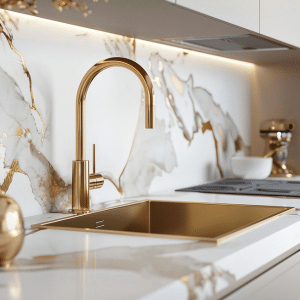Carrara Marble vs. Quartz: Which Countertop Material Is Right for You?

If you love the look of pristine white surfaces with the added dimension of soft gray veining, you can’t go wrong with classic Carrara marble countertops that evoke the gentle majesty of famous sculptures like Michelangelo’s Pietà or David.
However, you can achieve a similar aesthetic with marble-look quartz, which many homeowners find appealing. How can you choose the countertop material that’s right for your home?
What Is Carrara Marble?
Modern-day Tuscany is the birthplace of Carrara marble, which was first quarried in the mountains beyond the city of Carrara during the Roman Empire. This variety of marble features a soft white background marked by wispy gray veining that brushes the surface like morning fog on a northern lake.
Carrara marble countertops are known for their timeless, elegant appearance and tranquil aesthetic. White marble also offers a luminescent quality associated with the luster of calcite crystals that make up the stone.
This variety is often chosen for the quiet luxury it brings to interior design. Its versatile nature and soft, neutral hues pair well with other interior elements, making it easy to integrate into your overall design.
Benefits of Choosing Carrara Marble Countertops
Natural stone is a wonderful choice for home counter surfaces, adding luxury, beauty, and value to any interior space. Marble offers a durable, heat-resistant surface ideal for a kitchen or bathroom remodel. When properly sealed and maintained, it’s also resistant to staining, chipping, cracking, UV fading, and other types of damage.
In addition to practical benefits like strength and longevity, marble is considered among the most beautiful and versatile types of natural stone, pairing well with traditional and contemporary design styles. This transitional New York kitchen is a prime example, with elements of both.
Carrara marble countertops create a gentle transition between modern, bright white cabinets and a gray subway tile backsplash. However, the stone also adds breathtaking contrast to an island base in a warm mahogany wood tone. The blend of traditional and modern elements in this kitchen shows just how accommodating Carrara can be.
What Is Quartz?
Quartz is a naturally occurring mineral that can be found in a wide variety of hues. Engineered quartz countertops are made primarily of crushed quartz stone, which is paired with binding polymers and pigments to create attractive colors and patterns.
Several quartz manufacturers, including MSI, Cambria, and Silestone, use proprietary formulations and technologies to create slabs that provide the authentic look of the most popular natural stone varieties.
This durable surface material has gained popularity among homeowners for the many benefits it offers, particularly for busy, modern households. What might you discover when you choose quartz for your countertops?
Benefits of Quartz Countertops
Engineered quartz offers a wide array of practical and aesthetic advantages. First, it’s incredibly strong and durable, on par with the likes of resilient quartzite.
While it can’t tolerate heat as well as natural stone, quartz is resistant to staining, etching, scratching, chipping, and cracking. Even better, it requires no sealing and it can be cleaned with household solvents without fear of harming the surface.
Because it’s nonporous, quartz is also resistant to microbes like bacteria and mold, making for a food-safe surface.
With a range of unique designs, quartz makes for a beautiful addition to kitchen or bathroom spaces. If you’re keen on an upscale modern kitchen, you might opt for a mildly contrasting palette featuring white cabinets and pale, gray countertops, such as the Silestone Gris Expo surfaces in this traditional-turned-contemporary kitchen.
Or you could go for the starry appeal of HanStone Obsidian Black quartz paired with nude wood cabinets and flooring for an elevated Scandinavian style, as seen in this contemporary kitchen.
Marble-Look Quartz
You might be surprised by how closely engineered quartz can mimic natural stone like Carrara marble countertops. For example, consider this tonal white kitchen in Rye, NY.
An all-white kitchen can feel unremarkable unless you include elements designed to add depth and dimension. That starts with a subway tile backsplash in white, featuring a classic herringbone pattern that adds sophistication and subtle movement.
On the counter surface, Lattice quartz from PentalQuartz offers the look of white marble with feathery gray veining in the Carrara style. Fixtures and appliances in stainless steel, as well as door panels sporting a mercury mirror look, draw on the subtle hints of gray in countertops to create a harmonious balance.
Which Countertop Material Is Right for Your Home?
Quartz and Carrara marble countertops are both excellent choices for kitchens and bathrooms, each with unique benefits. If you want the luxury appeal of natural stone — and it must be the real deal — marble provides this prestige, which you can also turn into added value when selling your home.
However, if you manage a busy household full of kids, pets, and guests and you’re worried about the risk of damage and ongoing maintenance, engineered quartz may be more your speed. Either way, you’ll enjoy beautiful counter surfaces that serve as the focal point of your charming and elegant kitchen or spa-like en suite bath.
If you’re ready to start looking at marble and quartz slabs, visit an Academy Marble showroom in Bethel, CT, or Rye, NY, today.


